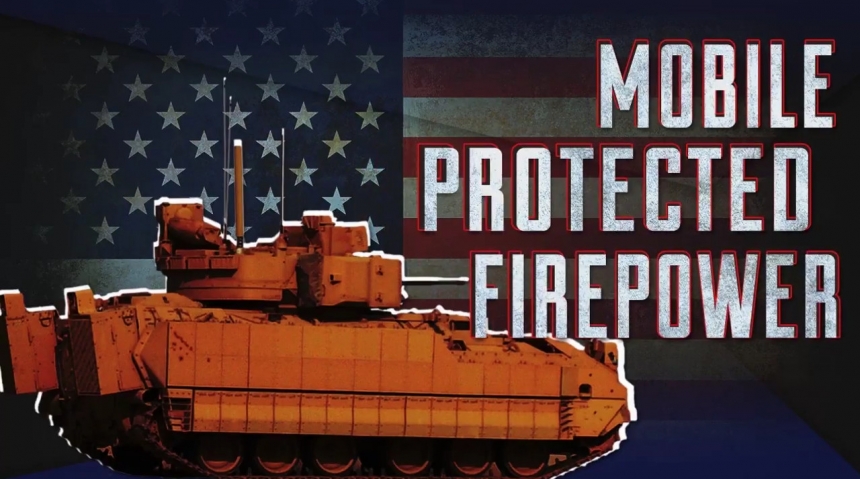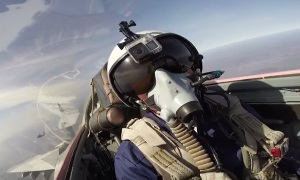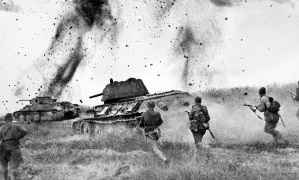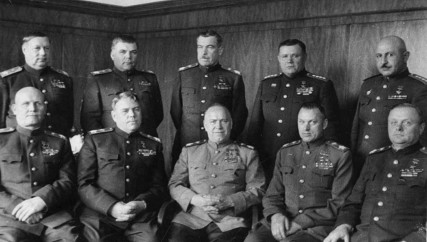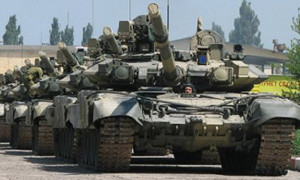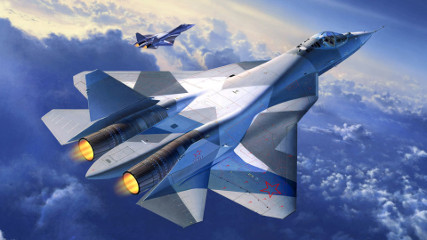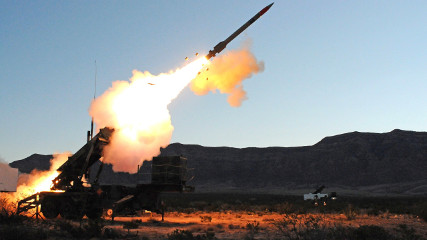Новая бронетехника американской армии
Новая бронетехника американской армии - программа перевооружения.
Новая бронетехника в программе перевооружения американской армии. Авторский перевод видео проекта SouthFront (Русский перевод Романа Попова).
В первой половине августа 2016 года командование учебное и разработки принципов боевого применения сухопутных войск США (TRADOC), расположенное в Форт Беннинг, штат Джордия, пригласило на встречу порядка 200 представителей оборонки, чтобы обсудить планы по приобретению боевой машины абсолютно нового типа. Программа называлась «Мобильное бронированное огневое средство» (MPF). Американская армия решила миновать бюрократизированную систему закупок для нужд армии, действовавшую в последние десятилетия, и приняла вместо нее TRADOC, больше всего известную тем, что если армии что-то требуется, то военные встречаются напрямую с промышленниками и работают с ними с самого начала процесса разработки боевой машины. Это позволяет с минимальными затратами, за счет существующих технологий и мощностей разработать работоспособный вариант. Очевидно, что американские военные усвоили некоторые уроки из ранее нереализованных программ.

MPF должна по планам быть высокомобильной боевой машиной, способной сопровождать и оказывать поддержку бригадным тактическим группам Stryker, мобильным и механизированным пехотным подразделениям и участвовать в задачах, связанным с разведкой боем. MPF будет компактной легкой гусеничной бронемашиной, способной действовать в условиях городской застройки и передвигаться по разбитым дорогам и мостам в слаборазвитых регионах по всему миру.
Корпорация General Dynamics уже предложила в качестве приемлемого варианта взять за основу шасси БРМ Эйджакс (Ajax), которая стоит на вооружении Британской армии. Машина получила название Гриффин, оснащена легким 120-мм танковым нарезным орудием с полностью закрытой башней, установленной на шасси Эйджакс. Орудие XM-360 было первоначально разработано в рамках программы Боевые системы будущего. Оно почти на 800 фунтов легче орудия, устанавливаемого на танк М1 Абрамс, оснащено дульным тормозом для снижения отдачи и автоматом заряжания, чтобы уменьшить численность экипажа на 1 человека. И хотя прототип по-прежнему находится на ранних стадиях разработки, американская армия надеется уже в середине 20х годов провести полевые испытания MPF.
В марте 2013 года была начата программа «Многоцелевой бронеавтомобиль» (AMPV). В декабре 2014 года BAE Systems выиграла тендер на поставку новой боевой машины и в декабре 2016 года представила первый серийный образец. За базу AMPV взяты машины семейства M2 Bradley, поэтому в ней присутствует множество компонентов Bradley и недавно разработанной M190A6 Paladin. Крайне логичным стало решение выпускать AMPV, которая обладает множеством преимуществ перед старыми машинами, для замены БТР М113. Новая машина гораздо шире М113, объем внутреннего пространства увеличен на 78%. Машина будет производиться в 5 вариантах: для общего использования; самоходный миномет; санитарный БТР; мобильный госпиталь и подвижной командный пункт.
Программа AMPV является, возможно, крупнейшей программой закупок для нужд армии США за последние 25 лет, и нацелена на обновление костяка механизированных подразделений.
Легкое боевое транспортное средство общего назначения (JLTV) совмещает в себе универсальность Хаммера с улучшенной мобильностью, вооружением, модульной бронезащитой и лучшими характеристиками бронетранспортёра с защитой от мин и нападений из засад (MRAP). Компания Oshkosh Defense, которая производит MRAP для нужд американской армии, летом 2015 года выиграла тендер на поставку JLTV. JLTV сочетает в себе мобильность, универсальность и защищенность, совмещая все это в зарекомендовавшем себя наборе существующих технологий. Бронемашина может быть оснащена пулеметами, гранатометом или 30-мм автоматической пушкой.
Судя по-всему, американская армия учла ошибки прошлого.
Written and produced by SF Team: Brian Kalman, Daniel Deiss, Edwin Watson
In the first half of August of 2016, the U.S. Army Training and Doctrine Command (TRADOC) located at Fort Benning, Georgia, invited almost 200 representatives from the defense industry to a meeting to discuss the desire to acquire a whole new type of vehicle. The program was named “Mobile Protected Firepower” (MPF). The U.S Army has decided to dispense with its overly bureaucratic acquisition system of past decades, and has instead had the TRADOC, the command that is most knowledgeable of what the Army requires, sit down directly with industry professionals from the very start to design a vehicle that takes existing technologies and capabilities to design a workable solution at minimal cost. Apparently, the U.S. Army has learned something from past failed programs.
In concept, the MPF is seen as a highly mobile vehicle that is able to accompany and support Stryker Brigade Combat Teams and mobile and mechanized infantry formations, and aid reconnaissance-in-force missions. The MPF will be a fully tracked armored vehicle light and small enough to negotiate urban areas, and traverse poor roads and bridges in underdeveloped regions of the globe.
General Dynamics has already proposed the use of the chassis of its Ajax vehicle, being produced as an armored recon vehicle for the British Army, as a possible starting point for an acceptable MPF prototype. Named the Griffin, the vehicle mounts the XM-360 light weight 120mm rifled tank gun in a fully enclosed turret on the Chassis of the Ajax. The XM-360 gun was originally designed during the height of the FCS program. It is about 800 pounds lighter than the gun mounted on the M1 Abrams tank, is fitted with a muzzle break to reduce recoil, and is equipped with an autoloader to reduce the crew requirement by one man. Although still in the early stages of prototype development, the U.S. Army hopes to field an MPF vehicle by the mid-2020s.
The Armored Multi-Purpose Vehicle (AMPV) program was initiated in March of 2013. BAE Systems was awarded the contract to supply the new vehicle in December of 2014, and unveiled the first production example in December of 2016. The AMPV is based on the M2 Bradley family of vehicle, and thus now shares many components with the Bradley and newly designed M190A6 Paladin. An M2 Bradley based vehicle to replace the M113 was extremely logical and offers many benefits over the older design. The new vehicle is much larger than the M113, offering 78% more internal volume. Five variants are being produced; General Purpose, Mortar Carrier, Armored Ambulance, Mobile Medical Clinic and Mobile Command vehicle.
General Purpose. This is an armored personnel carrier designed to move troops and materiel.
Mortar Carrier. This vehicle provides fire support to mechanized units. A 120mm mortar will be carried.
Armored Ambulance. This variant provides armored emergency transport of casualties to rearward medical facilities.
Mobile Medical Clinic. Allows the forward positioning of medical services closer to the combat area.
Mobile Command Vehicle. Providing commanders superior battlefield situational awareness and command and control capability when and where it is needed most.
Probably the most important procurement program of the last quarter of a century for the U.S. Army, the AMPV will modernize the lifeblood of the services mechanized units.
The Joint Light Tactical vehicle (JLTV) combines the utility of the HMMWV with increased mobility, armament, multiple modular armor protection packages, and the best IED defeating qualities of a Mine Resistant Ambush Protected vehicle (MRAP). Oshkosh Defense, who produces the M-ATV for the U.S. military, was awarded the JLTV contract in the summer of 2015. The JLTV balances mobility, utility and protection in a proven combination of existing technologies. The vehicle can be equipped with machine guns, a grenade launcher, or a 30mm autocannon.
The U.S. Army seemed to acknowledge its own failures in recent years, and revised its acquisition process in a number of key areas. The AMPV, JLTV and MPS programs illustrate a more pragmatic approach, aiming for more realistic goals and relying on improving upon existing, proven technology. The U.S. Army is playing catch-up to acquire the armored vehicles desperately required to replace aged and outdated fleets. It remains to be seen how financial constraints will effect these programs, as a new Trump administration, which has vowed to strengthen and rebuild the U.S. military, takes over executive functions in January of 2017.
The leadership of the U.S. Army is faced with the challenge of maintaining a material and technological edge over its “Near-Peer” challengers, Russia and China. Both of these nations have developed impressive and capable armored vehicles during the years when the U.S. Army was throwing money down the drain. The battlefield accomplishments of the Russian T-90 MBT and TOS-1 Self-Propelled Rocket Artillery have been demonstrated in Syria, with the T-90 being the only advanced tank in theater proven to survive ATGM attacks on more than one occasion. New Chinese armored vehicles, though unproven in combat, are surely drawing the interested attention of the U.S. defense industry and the U.S. Army top leadership.
It appears that the U.S. Army has finally turned the page on its failed acquisition efforts, and is progressing in the right direction; however, it must rely on updated legacy systems for at least another decade before new vehicles start making their presence felt in significant numbers.
